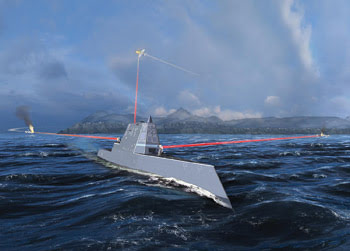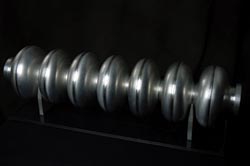A solitary US naval warship is at sea when a fleet of ships surrounds it armed with hypervelocity cruise missiles and electromagnetic rail guns. Although it may be outnumbered, the warship has something the other ships don’t – an ultraprecise, ultrafast, megawatt-class laser system with a selectable wavelength for optimum performance in any maritime condition.
This future weaponized laser system is part of an extensive program designed to enhance free-electron lasers (FELs) into 100-kW and megawatt-class power systems for lethal and low-collateral-damage sea and air attacks.

A naval warship outfitted with a megawatt-class laser system uniquely uses countersurveillance and situational awareness to target multiple opponents at once. Its point defense capability also supplies high-resolution imaging and beam direction for precision aiming. Courtesy of Raytheon Co.
The plan is “to design, develop, fabricate, integrate and test a complete 10-kW-class FEL prototype device that can be used to demonstrate scalability of the necessary FEL physics and engineering for an eventual megawatt-class FEL device,” said Sarwat Chappell, direct energy program officer at the Arlington, Va.-based Office of Naval Research, which advances innovative science and technology capabilities for the Navy and Marine Corps.
“The speed-of-light engagement characteristic and the ability to select the wavelength to maximize laser transmission through the marine atmosphere of the FEL weapons systems give the US Navy the unique ability to adjust for defense against targets in any maritime environment throughout the world,” she added.
Two companies are competing to develop the laser, The Boeing Co.’s Directed Energy Systems Div. in West Hills, Calif., and Raytheon Co.’s Integrated Defense Systems Div. in Tewksbury, Mass. Each has been awarded a 12-month, $6.9 million contract from the Office of Naval Research. The project is estimated to reach $163 million to fully complete a 100-kW demonstration prototype.
Ready …
Free-electron lasers work by injecting a number of electrons into a linear accelerator, where they are amplified to very high energy levels. Directed through a sequence of powerful electromagnetic fields, the electrons emit energy, creating an intense laser beam. “The FEL is the only all-electric laser that is capable of producing megawatt-and-above powers,” said Gary Fitzmire, vice president and program director of Boeing’s Directed Energy Systems.

A linear accelerator of a free-electron laser is shown. To operate the system, clusters of electrons are injected into the device and stripped from their atoms, resulting in very high energy levels. From there, they are directed through a series of powerful electromagnetic fields, forcing the release of energy in the form of photons. Engineers will be able to adjust the wavelength to successfully propagate through any atmospheric condition by increasing the amount of clusters of electrons injected into the accelerator or the amount of electrons in each cluster. Courtesy of the US Navy.
To enhance energy, two variables of the system must be changed. The first includes increasing the number of times an electron group is injected into the accelerator, and the second, increasing the number of electrons.
Unlike other lasers that use chemicals to fuel the system, the laser will run off a ship’s power, eliminating the need for explosive or toxic materials onboard. And because the FEL has unlimited magazine capacity, it will eliminate the need for storing missiles while lessening the concern for having enough artillery to keep up with maritime warfare.
“FEL has, over the past decade [and] with continuing support from the [Office of Naval Research], the promise of being able to reach the power levels required to make this a defensive weapon system without some of the drawbacks that some of the other technologies have,” said John Cochran, senior engineering fellow and program manager of Raytheon.
Aim …
The idea behind advancing the laser is to have selectable wavelengths for use at sea. “One of the key benefits of the free-electron laser is that it is tunable in both its power levels and its wavelengths,” Cochran said. Energy sources are absorbed by elements in the atmosphere, such as heat and humidity, he added.
To facilitate a successful and powerful laser beam that propagates through the atmosphere and that will not become absorbed, various wavelengths must be available – depending on environmental conditions – on a day-to-day basis. In addition, adjusting the power allows for fully destroying a target or for merely disabling it.
The laser also provides a point-defense capability that uses high-resolution imaging and a beam director to pinpoint a specific spot on a target quickly and accurately. “The combination of these two effects allows the system to destroy the target in the minimum time,” said Edward W. Pogue, Boeing’s FEL program manager.
Countersurveillance and situational awareness provide the FEL with the capability of engaging in multiple target attacks, thus reducing mobility tactics that opponents may use to avoid a strike. Incoming missiles can dodge kinetic receptors, but they won’t be able to avoid the laser beam because the speed of light performance identifies and destroys the target before it can reposition to a new course, Pogue added.
Upgrade!
Boeing and Raytheon are both in the preliminary stages of augmenting the laser system, which will require three phases. The first, 1A, will involve a year of constructing an introductory design proposal for the 100-kW prototype FEL system, while the second phase, 1B, will be to create a detailed design. The third, phase 2, will be the fabrication, integration and testing of the FEL prototype.
The Office of Naval Research will choose which company – if not both – is best suited to carry out the megawatt-class system project based entirely on its preliminary plan. “Upon successful completion of phase 1A, selected performers will participate in future phases, leading to development and demonstration of the 100-kW prototype,” the Navy’s Chappell said.
FELs are not a new technology for military weapons applications. “Many research FELs have been built to-date worldwide, albeit none near MW class average power levels,” Chappell said.
Nevertheless, upgrading the laser to 100 kW and ultimately scaling up to megawatt-class power will change military defense tactics for the advancement of injectors, beam control, accelerators, amplifier and oscillator designs, and other FEL weaponry, while providing directed energy systems for a future all-electric naval ship for maritime defense.